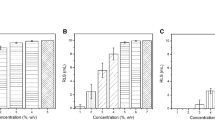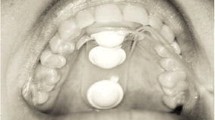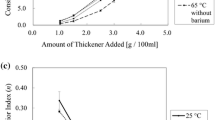Abstract
Individuals with dysphagia may be prescribed thickened fluids to promote a safer and more successful swallow. Starch-based thickening agents are often employed; however, these exhibit great variation in consistency. The aim of this study was to compare viscosity and the rheological profile parameters complex (G*), viscous (G″), and elastic modulus (G′) over a range of physiological shear rates. UK commercially available dysphagia products at “custard” consistency were examined. Commercially available starch-based dysphagia products were prepared according to manufacturers’ instructions; the viscosity and rheological parameters were tested on a CVOR Rheometer. At a measured shear rate of 50 s−1, all products fell within the viscosity limits defined according to the National Dysphagia Diet Task Force guidelines. However, at lower shear rates, large variations in viscosity were observed. Rheological parameters G*, G′, and G″ also demonstrated considerable differences in both overall strength and rheological behavior between different batches of the same product and different product types. The large range in consistency and changes in the overall structure of the starch-based products over a range of physiological shear rates show that patients could be receiving fluids with very different characteristics from that advised. This could have detrimental effects on their ability to swallow.




Similar content being viewed by others
References
Groher ME, editor. Dysphagia: diagnosis and management. 3rd ed. Philadelphia: Butterworth-Hienemann (Elsevier Group); 1997.
Leslie P, Carding PN, Wilson JA. Investigation and management of chronic dysphagia. BMJ. 2003;326:433–6.
Logemann JA. Evaluation and treatment of swallowing disorders. 2nd ed. Austin: Pro-Ed; 1998.
BAPEN, Elia M, Russell CA, editor. Combating malnutrition: recommendations for action. Report from the Advisory Group on Malnutrition led by BAPEN; 2009.
Logemann JA. Swallowing disorders. Best Pract Res Clin Gastroenterol. 2007;21(4):563–73.
Dantas RO, Kern MK, Massey B, Dodds WJ, Kahrilas PJ, Brasseur JG, et al. Effect of swallowed bolus variables on oral and pharyngeal phases of swallowing. Am J Physiol. 1990;258(5):G675–81.
Taniguchi H, Tsukada T, Ootaki S, Yamanda Y, Makoto I. Correspondence between food consistency and suprahyoid muscle activity, tongue pressure and bolus transit times during the oropharyngeal phase of swallowing. J Appl Physiol. 2008;105:791–9.
Steele CM, Van Lieshout PHHM. Influence of bolus consistency on lingual behaviours in sequential swallowing. Dysphagia. 2004;19:192–206.
Whelan K. Inadequate fluid intakes in dysphagic acute stroke. Clin Nutr. 2001;20(5):423–8.
Sharpe K, Ward L, Cichero J, Sopade P, Halley P. Thickened fluids and water absorption in rats and humans. Dysphagia. 2007;22:193–203.
Atherton M, Bellis-Smith N, Cichero J, Suter M. Texture modified foods and thickened fluids as used for individuals with dysphagia: Australian standardised labels and definitions. Nutr Diet. 2007;64(Suppl 2):S53–76.
National Dysphagia Diet Task Force. The national dysphagia diet: standardisation for optimal care. Chicago: American Dietetic Association; 2002.
Cutler AN, Morris ER, Taylor LJ. Oral perception of viscosity in fluids foods and model systems. J Texture Stud. 1983;14:377–95.
Dickie AM, Kokini JL. An improved model for food thickness from non-Newtonian fluid mechanics in the mouth. J Food Sci. 1983;48(1):57–65.
Shama F, Parkinson C, Sherman P. Identification of stimuli controlling the sensory evaluation of viscosity I. Non-oral methods. J Texture Stud. 1973;4:104–10.
Shama F, Sherman P. Identification of stimuli controlling the sensory evaluation of viscosity II. Oral methods. J Texture Stud. 1973;4:111–8.
Royal College of Speech and Language Therapists and British Dietetic Association. National descriptors for texture modification in adults. London: RCSLT; 2002, reviewed April 2009.
British Dietetic Association, Dietetics Today. Joint RCSLT and BDA national descriptors for texture modification in adults, vol. 41, issue 8; 2006. p. 7.
Matta Z, Chambers E, Garcia JM, Helverson JM. Sensory characteristics of beverages prepared with commercial thickeners used for dysphagia diets. J Am Diet Assoc. 2006;106(7):1049–54.
Lotong V, Chun E, Chambers E, Garcia JM. Texture and flavour characteristics of beverages containing commercial thickening agents for dysphagia diets. J Food Sci. 2003;68(4):1537–41.
Sopade PA, Halley PJ, Cichero JAY, Ward LC, Liu J, Varliveli S. Rheological characterisation of food thickeners marketed in Australia in various media for the management of dyaphagia III. Fruit juice as a dispersal medium. J Food Eng. 2008;86:604–15.
Sopade PA, Halley PJ, Cichero JAY, Ward LC, Liu J. Rheological characterisation of food thickeners marketed in Australia in various media for the management of dysphagia I. Water and cordial. J Food Eng. 2007;79:69–82.
Garcia JM, Chambers E, Matta MA, Clark M. Viscosity measurements of nectar- and honey-thick liquids: product, liquid and time comparisons. Dysphagia. 2005;20:325–35.
Dewar RJ, Joyce MJ. Time-dependent rheology of starch-based thickeners and the clinical implications for dysphagia therapy. Dysphagia. 2006;20:325–35.
Garcia JM, Chambers E, Matta Z, Clark M. Serving temperature viscosity measurements of nectar- and honey-thick liquids. Dysphagia. 2008;23:265–9.
Adeleye B, Rachal C. Comparison of the rheological properties of ready-to-serve and powdered instant food-thickened beverages at different temperatures for dysphagic patients. J Am Diet Assoc. 2007;107(7):1176–82.
Smith TL, Sun MM, Pippin J. Characterizing process control of fluid viscosities in nursing homes. J Am Diet Assoc. 2004;104(6):969–71.
Turi EA. Thermal characterisation of polymeric materials. vol. 1, 2nd ed. New York: Academic Press; 1997.
Ferry JD. Viscoelastic properties of polymers. 3rd ed. New York: Wiley; 1980.
Nicosia MA, Robbins J. The fluid mechanics of bolus ejection from the oral cavity. J Biomech. 2001;34:1537–44.
Meng Y, Rao MA, Datta AK. Computer simulation of the pharyngeal bolus transport of Newtonian and non-Newtonian fluids. Food Byprod Process. 2005;83(C4):297–305.
Steele CM, Van Lieshout PHHM, Goff HD. The rheology of liquids: a comparison of clinicians’ subjective impressions and objective measurement. Dysphagia. 2003;18:182–95.
Glassburn DL, Deem JF. Thickener viscosity in dysphagia management: variability among speech-language pathologists. Dysphagia. 1998;13:218–22.
Cichero JAY, Jackson O, Halley PJ, Murdoch BE. How thick is thick? Multicenter study of the rheological and material property characteristics of mealtime fluids and videofluoroscopy fluids. Dysphagia. 2000;15:188–200.
Strowd L, Kyzima J, Pillsbury D, Valley T, Rubin B. Dysphagia dietary guidelines and the rheology of nutritional feeds and barium test feeds. Chest. 2008;133(6):1397–401.
Acknowledgments
The authors acknowledge funding from ERSC under the New Dynamics of Ageing study MAPP-MAL (Multidisciplinary Approach to a Prototype for Prevention of Malnutrition in older people: products, places, people and procedures).
Author information
Authors and Affiliations
Corresponding author
Rights and permissions
About this article
Cite this article
Payne, C., Methven, L., Fairfield, C. et al. Consistently Inconsistent: Commercially Available Starch-Based Dysphagia Products. Dysphagia 26, 27–33 (2011). https://doi.org/10.1007/s00455-009-9263-7
Received:
Accepted:
Published:
Issue Date:
DOI: https://doi.org/10.1007/s00455-009-9263-7




